Surface Modification of AM60 Mg-Al Alloy with Vanadium and V2O5 Sputtered Deposits: Activity in Marine Ambience
Abstract
:1. Introduction
2. Materials and Methods
2.1. Samples of AM60 and SME Model Solution
2.2. Coating Deposition
2.3. Immersion Test and Surface Characterization
3. Results
3.1. Morphology of the Vanadium and V2O5 Deposits on AM60 Surface
3.2. Raman Spectra and XPS Analysis of the Sputtered Deposits on AM60 Alloy Surface
3.3. Analysis of V-AM60 and V2O5-AM60 after Immersion in SME Marine Model Solution
4. Conclusions
Author Contributions
Funding
Institutional Review Board Statement
Informed Consent Statement
Data Availability Statement
Acknowledgments
Conflicts of Interest
References
- Joost, W.J. Reducing Vehicle Weight and Improving U.S. Energy Efficiency Using Integrated Computational Materials Engineering. JOM 2012, 64, 1032–1038. [Google Scholar] [CrossRef]
- Mordike, B.L.; Ebert, T. Magnesium Properties-Applications-Potential. Mater. Sci. Eng. A 2001, 302, 37–45. [Google Scholar] [CrossRef]
- Powell, B.R.; Krajewski, P.E.; Luo, A.A. Magnesium Alloys for Lightweight Powertrains and Automotive Structures. In Materials, Design and Manufacturing for Lightweight Vehicles, 2nd ed.; Mallick, P.K., Ed.; Elsevier: Amsterdam, The Netherlands, 2020; pp. 125–186. [Google Scholar] [CrossRef]
- Makar, G.L.; Kruger, J. Corrosion of Magnesium. Int. Mater. Rev. 1993, 38, 138–153. [Google Scholar] [CrossRef]
- Altun, H.; Sen, S. Studies on the Influence of Chloride Ion Concentration and pH on the Corrosion and Electrochemical Behaviour of AZ63 Magnesium Alloy. Mater. Des. 2004, 25, 637–643. [Google Scholar] [CrossRef]
- Kainer, K.U.; Srinivasan, P.B.; Blawert, C.; Dietzel, W. Corrosion of Magnesium and Its Alloys. In Shreir’s Corrosion—Corrosion and Degradation of Engineering Materials; Cottis, B., Graham, M., Lindsay, R., Lyon, S., Richardson, T., Scantlebury, D., Stott, H., Eds.; Elsevier: Amsterdam, The Netherlands, 2010; Volume 3, pp. 2011–2041. [Google Scholar] [CrossRef]
- Song, G.L.; Atrens, A. Corrosion Mechanisms of Magnesium Alloys. Adv. Eng. Mater. 1999, 1, 11–33. [Google Scholar] [CrossRef]
- Haynes, W.M.; Lide, D.R.; Bruno, T.J. Section 5 Thermochemistry, Electrochemistry, and Solution Chemistry. In CRC Handbook of Chemistry and Physics 97th Edition, 97th ed.; Haynes, W.M., Lide, D.R., Bruno, T.J., Eds.; CRC Press: Boca Raton, FL, USA, 2017; pp. 167–173. [Google Scholar] [CrossRef]
- Lunder, O. Corrosion Resistance of Cast Mg-Al Alloys. Corros. Rev. 1997, 15, 439–470. [Google Scholar] [CrossRef]
- Hu, H.; Nie, X.; Ma, Y. Corrosion and Surface Treatment of Magnesium Alloys. In Magnesium Alloys—Properties in Solid and Liquid States; Czerwinski, F., Ed.; IntechOpen: London, UK, 2014; pp. 67–108. [Google Scholar] [CrossRef]
- Mehran, Q.M.; Fazal, M.A.; Bushroa, A.R.; Rubaiee, S. A Critical Review on Physical Vapor Deposition Coatings Applied on Different Engine Components. Crit. Rev. Solid State Mater. Sci. 2018, 43, 158–175. [Google Scholar] [CrossRef]
- Rossnagel, S.M. Directional and Ionized Physical Vapor Deposition for Microelectronics Applications. J. Vac. Sci. Technol. B 1998, 16, 2585. [Google Scholar] [CrossRef]
- Altun, H.; Sen, S. The Effect of PVD Coatings on the Corrosion Behaviour of AZ91 Magnesium Alloy. Mater. Des. 2005, 27, 1174–1179. [Google Scholar] [CrossRef]
- Mathew, M.T.; Ariza, E.; Rocha, L.A.; Fernandes, A.C.; Vaz, F. TiCxOy Thin Films for Decorative Applications: Tribocorrosion Mechanisms and Synergism. Tribol. Int. 2008, 41, 603–615. [Google Scholar] [CrossRef]
- Calderon, S.; Alves, C.F.A.; Manninen, N.K.; Cavaleiro, A.; Carvalho, S. Electrochemical Corrosion of Nano-Structured Magnetron-Sputtered Coatings. Coatings 2019, 9, 682. [Google Scholar] [CrossRef]
- Moshfegh, A.Z. PVD Growth Methods: Physics and Technology. In Proceedings of the Physics and Technology of Thin films: IWTF 2003; Moshfegh, A.Z., Känel, H.V., Kashyap, S.C., Wuttig, M., Eds.; World Scientific: Singapore, 2004; pp. 28–53. [Google Scholar] [CrossRef]
- Sproul, W.D. Physical Vapor Deposition Tool Coatings. Surf. Coat. Technol. 1996, 81, 1–7. [Google Scholar] [CrossRef]
- Baptista, A.; Silva, F.J.G.; Porteiro, J.; Míguez, J.L.; Pinto, G.; Fernandes, L. On the Physical Vapour Deposition (PVD): Evolution of Magnetron Sputtering Processes for Industrial Applications. Procedia Manuf. 2018, 17, 746–757. [Google Scholar] [CrossRef]
- Hoche, H.; Groß, S.; Oechsner, M. Development of New PVD Coatings for Magnesium Alloys with Improved Corrosion Properties. Surf. Coat. Technol. 2014, 259, 102–108. [Google Scholar] [CrossRef]
- Petkoska, A.T.; Nasov, I. Surface Engineering of Polymers-Case Study: PVD Coatings on Polymers. Zast. Mater. 2014, 55, 3–10. [Google Scholar] [CrossRef]
- Schlain, D.; Kenahan, C.B.; Acherman, W.L. Corrosion Properties of High-Purity Vanadium. J. Less-Common Met. 1961, 3, 458–467. [Google Scholar] [CrossRef]
- Li, C.-W.; Tian, X.-B.; Liu, T.-W.; Qin, J.-W.; Gong, C.-Z. Microstructure and Corrosion Resistance of Vanadium Films Deposited at Different Target-Substrate Distance by HPPMS. Rare Met. 2014, 33, 587–593. [Google Scholar] [CrossRef]
- Sun, R.; Yang, S.; Lv, T. Corrosion Behavior of AZ91D Magnesium Alloy with a Calcium–Phosphate–Vanadium Composite Conversion Coating. Coatings 2019, 9, 379. [Google Scholar] [CrossRef]
- Zhongli, Z.; Ning, L.I.; Deyu, L.I. Corrosion Protection Properties of Vanadium Films Formed on Zinc Surfaces. Rare Met. 2011, 30, 146. [Google Scholar] [CrossRef]
- Liu, J.; Wang, X.; Peng, Q.; Li, Y. Preparation and Gas Sensing Properties of Vanadium Oxide Nanobelts Coated with Semiconductor Oxides. Sens. Actuators Chem. B 2006, 115, 481–487. [Google Scholar] [CrossRef]
- Cheng, K.C.; Chen, F.R.; Kai, J.J. V2O5 Nanowires as a Functional Material for Electrochromic Device. Sol. Energy Mater. Solar Cells 2006, 90, 1156–1165. [Google Scholar] [CrossRef]
- Singhal, A.; Skandan, G.; Amatucci, G.; Badway, F.; Ye, N.; Manthiram, A.; Ye, H.; Xu, J.J. Nanostructured Electrodes for next Generation Rechargeable Electrochemical Devices. J. Power Sources 2004, 129, 38–44. [Google Scholar] [CrossRef]
- Lukong, V.T.; Ukoba, K.; Jen, T.C. Fabrication of Vanadium Dioxide Thin Films and Application of Its Thermochromic and Photochromic Nature in Self-Cleaning: A Review. Energy Environ. 2023, 34, 3495–3528. [Google Scholar] [CrossRef]
- Beke, S. A Review of the Growth of V2O5 Films from 1885 to 2010. Thin Solid Films 2011, 519, 1761–1771. [Google Scholar] [CrossRef]
- Su, Q.; Lan, W.; Wang, Y.Y.; Liu, X.Q. Structural Characterization of β-V2O5 Films Prepared by DC Reactive Magnetron Sputtering. Appl. Surf. Sci. 2009, 255, 4177–4179. [Google Scholar] [CrossRef]
- Hwang, K.S.; Kang, B.A.; Kim, S.D.; Hwangbo, S.; Kim, J.T. Amorphous Vanadium Pentoxide Thin Films Prepared by Electrostatic Spraying-Pyrolysis Deposition. Ceram. Int. 2011, 38, S645–S647. [Google Scholar] [CrossRef]
- Mazur, M.; Lubańska, A.; Domaradzki, J.; Wojcieszak, D. Complex Research on Amorphous Vanadium Oxide Thin Films Deposited by Gas Impulse Magnetron Sputtering. Appl. Sci. 2022, 12, 8966. [Google Scholar] [CrossRef]
- Diaz-Fernandez, Y.; Malavasi, L.; Quartarone, E. Flexible Deposition of Nanocrystalline Vanadium Oxide Thin Films. J. Mater. Chem. 2008, 18, 5190–5192. [Google Scholar] [CrossRef]
- Velayutham, R.; Manikandan, R.; Raj, C.J.; Kale, A.M.; Kaya, C.; Palanisamy, K.; Kim, B.C. Electrodeposition of vanadium pentoxide on carbon fiber cloth as a binder-free electrode for high-performance asymmetric supercapacitor. J. Alloys Compd. 2021, 863, 158332. [Google Scholar] [CrossRef]
- Li, J.; He, Y.; Sun, Y.; Zhang, X.; Shi, W.; Ge, D. Synthesis of Polypyrrole/V2O5 Composite Film on the Surface of Magnesium Using a Mild Vapor Phase Polymerization (VPP) Method for Corrosion Resistance. Coatings 2020, 10, 402. [Google Scholar] [CrossRef]
- Chávez, L.; Veleva, L.; Sánchez, G.; Dieringa, H. AM60-AlN Nanocomposite and AM60 Alloy Corrosion Activity in Simulated Marine-Coastal Ambience. Metals 2022, 12, 1997. [Google Scholar] [CrossRef]
- Chávez, L.; Veleva, L.; Sánchez-Ahumada, D.; Ramírez-Bon, R. Hybrid Coating of Polystyrene–ZrO2 for Corrosion Protection of AM Magnesium Alloys. Coatings 2023, 13, 1059. [Google Scholar] [CrossRef]
- ASTM G31-12; Standard Guide for Laboratory Immersion Corrosion Testing of Metals. ASTM International: West Conshohocken, PA, USA, 2021.
- Shvets, P.; Dikaya, O.; Maksimova, K.; Goikhman, A. A Review of Raman Spectroscopy of Vanadium Oxides. J. Raman Spectrosc. 2019, 50, 1226–1244. [Google Scholar] [CrossRef]
- Gauntt, B.D.; Li, J.; Cabarcos, O.M.; Basantani, H.A.; Venkatasubramanian, C.; Bharadwaja, S.S.N.; Podraza, N.J.; Jackson, T.N.; Allara, D.L.; Antrazi, S.; et al. Microstructure of Vanadium Oxide Used in Microbolometers. In the Infrared Technology and Applications XXXVII., Proceedings of the SPIE, Orlando, FL, USA, 21 May 2011; Volume 8012, p. 80123T. [CrossRef]
- Petrov, G.I.; Yakovlev, V.V.; Squier, J. Raman Microscopy Analysis of Phase Transformation Mechanisms in Vanadium Dioxide. Appl. Phys. Lett. 2002, 81, 1023–1025. [Google Scholar] [CrossRef]
- Marini, C.; Arcangeletti, E.; Castro, D.D.; Baldassare, L.; Perucchi, A.; Lupi, S.; Malavasi, L.; Boeri, L.; Pomjakushina, E.; Conder, K.; et al. Optical Properties of V1−xCrxO2 Compounds under High Pressure. Phys. Rev. B 2008, 77, 235111. [Google Scholar] [CrossRef]
- Plugaru, R.; Mihalache, I.; Romaniţan, C.; Comanescu, F.; Vulpe, S.; Craciun, G.; Plugaru, N.; Djourelov, N. Light-Sensing Properties of Amorphous Vanadium Oxide Films Prepared by RF Sputtering. Sensors 2023, 23, 1759. [Google Scholar] [CrossRef] [PubMed]
- Qing, S.; Xiajun, P.; Erqing, X.; Yinyue, W.; Jiawen, Q.; Xueqin, L. Influence of Temperature on the Microstructure of V2O5 Film Prepared by DC Magnetron Sputtering. Rare Metals 2006, 25, 82. [Google Scholar] [CrossRef]
- Julien, C.; Nazri, G.A.; Bergström, O. Raman Scattering Studies of Microcrystalline V6O13. Phys. Status Solid. B Basic Res. 1997, 201, 319–326. [Google Scholar] [CrossRef]
- Rana, A.; Rana, A.S. Investigation of VxOy Thin Films Using Raman Spectroscopy: Role of Oxygen Vacancies and Structural Phase Transformation on Thermochromic Properties. Mater. Today Proc. 2023. [Google Scholar] [CrossRef]
- Huotari, J.; Lappalainen, J.; Eriksson, J.; Bjorklund, R.; Heinonen, E.; Miinalainen, I.; Puustinen, J.; Spetz, A.L. Synthesis of Nanostructured Solid-State Phases of V7O16 and V2O5 Compounds for Ppb-Level Detection of Ammonia. J. Alloys Compd. 2016, 675, 433–440. [Google Scholar] [CrossRef]
- Hu, P.; Hu, P.; Vu, T.D.; Li, M.; Wang, S.; Ke, Y.; Zeng, X.; Mai, L.; Long, Y. Vanadium Oxide: Phase Diagrams, Structures, Synthesis, and Applications. Chem. Rev. 2023, 123, 4353–4415. [Google Scholar] [CrossRef] [PubMed]
- Demeter, M.; Neumann, M.; Reichelt, W. Mixed-Valence Vanadium Oxides Studied by XPS. Surf. Sci. 2000, 454, 41–44. [Google Scholar] [CrossRef]
- Mendialdua, J.; Casanova, R.; Barbaux, Y. XPS Studies of V2O5, V6O13, VO2 and V2O3. J. Electron Spectros. Relat. Phenom. 1995, 71, 249–261. [Google Scholar] [CrossRef]
- Silversmit, G.; Depla, D.; Poelman, H.; Marin, G.B.; De Gryse, R. Determination of the V2p XPS Binding Energies for Different Vanadium Oxidation States (V5+ to V0+). J. Electron Spectros. Relat. Phenom. 2004, 135, 167–175. [Google Scholar] [CrossRef]
- Werfel, F.; Dräger, G.; Berg, U. X-Ray and X-Ray Photoelectron Spectra of Vanadium Oxides. Cryst. Res. Technol. 1981, 16, 119–126. [Google Scholar] [CrossRef]
- Lindström, R.; Maurice, V.; Zanna, S.; Klein, L.; Groult, H.; Perrigaud, L.; Cohen, C.; Marcus, P. Thin Films of Vanadium Oxide Grown on Vanadium Metal: Oxidation Conditions to Produce V2O5 Films for Li-Intercalation Applications and Characterisation by XPS, AFM, RBS/NRA. Surf. Interface Anal. 2006, 38, 6–18. [Google Scholar] [CrossRef]
- Sarma, D.D.; Rao, C.N.R. XPES Studies of Oxides of Second- and Third-Row Transition Metals Including Rare Earths. J. Electron Spectros. Relat. Phenom. 1980, 20, 25–45. [Google Scholar] [CrossRef]
- Trypuc, M.; Kiełkowska, U.; Chałat, M. Articles Solubility Investigations in the NaCl + V2O5 + H2O System from 293 K to 323 K. J. Chem. Eng. Data 2002, 47, 765–767. [Google Scholar] [CrossRef]
- Song, Y.; Shan, D.; Chen, R.; Zhang, F.; Han, E.H. Biodegradable Behaviors of AZ31 Magnesium Alloy in Simulated Body Fluid. Mater. Sci. Eng. C 2009, 29, 1039–1045. [Google Scholar] [CrossRef]
- Lv, T.; Peng, Y.; Zhang, G.; Jiang, S.; Yang, Z.; Yang, S.; Pang, H. How About Vanadium-Based Compounds as Cathode Materials for Aqueous Zinc Ion Batteries? Adv. Sci. 2023, 10, 2206907. [Google Scholar] [CrossRef]
- Ding, Y.L.; Wen, Y.; Wu, C.; Van Aken, P.A.; Maier, J.; Yu, Y. 3D V6O13 Nanotextiles Assembled from Interconnected Nanogrooves as Cathode Materials for High-Energy Lithium Ion Batteries. Nano Lett. 2015, 15, 1388–1394. [Google Scholar] [CrossRef] [PubMed]
- Xu, X.; Xiong, F.; Meng, J.; Wang, X.; Niu, C.; An, Q.; Mai, L. Vanadium-Based Nanomaterials: A Promising Family for Emerging Metal-Ion Batteries. Adv. Funct. Mater. 2020, 30, 1904398. [Google Scholar] [CrossRef]
- Liu, Y.; Wu, X. Review of Vanadium-Based Electrode Materials for Rechargeable Aqueous Zinc Ion Batteries. J. Energy Chem. 2021, 56, 223–237. [Google Scholar] [CrossRef]
- Yan, Y.; Li, B.; Guo, W.; Pang, H.; Xue, H. Vanadium Based Materials as Electrode Materials for High Performance Supercapacitors. J. Power Sources 2016, 329, 148–169. [Google Scholar] [CrossRef]
- Rasoulis, M.; Vernardou, D. Electrodeposition of Vanadium Oxides at Room Temperature as Cathodes in Lithium-Ion Batteries. Coatings 2017, 7, 100. [Google Scholar] [CrossRef]
- Pei, C.; Jin, M.; Yin, Y.; Xiong, F.; Jiang, Y.; Yuan, X.; Wang, F.; An, Q. Intercalation-Type V2O3 with Fast Mg2+ Diffusion Kinetics for High-Capacity and Long-Life Mg-Ion Storage. ACS Sustain. Chem. Eng. 2020, 8, 16164–16171. [Google Scholar] [CrossRef]
- Zuo, C.; Tang, W.; Lan, B.; Xiong, F.; Tang, H.; Dong, S.; Zhang, W.; Tang, C.; Li, J.; Ruan, Y.; et al. Unexpected Discovery of Magnesium-Vanadium Spinel Oxide Containing Extractable Mg2+ as a High-Capacity Cathode Material for Magnesium Ion Batteries. Chem. Eng. J. 2021, 405, 127005. [Google Scholar] [CrossRef]
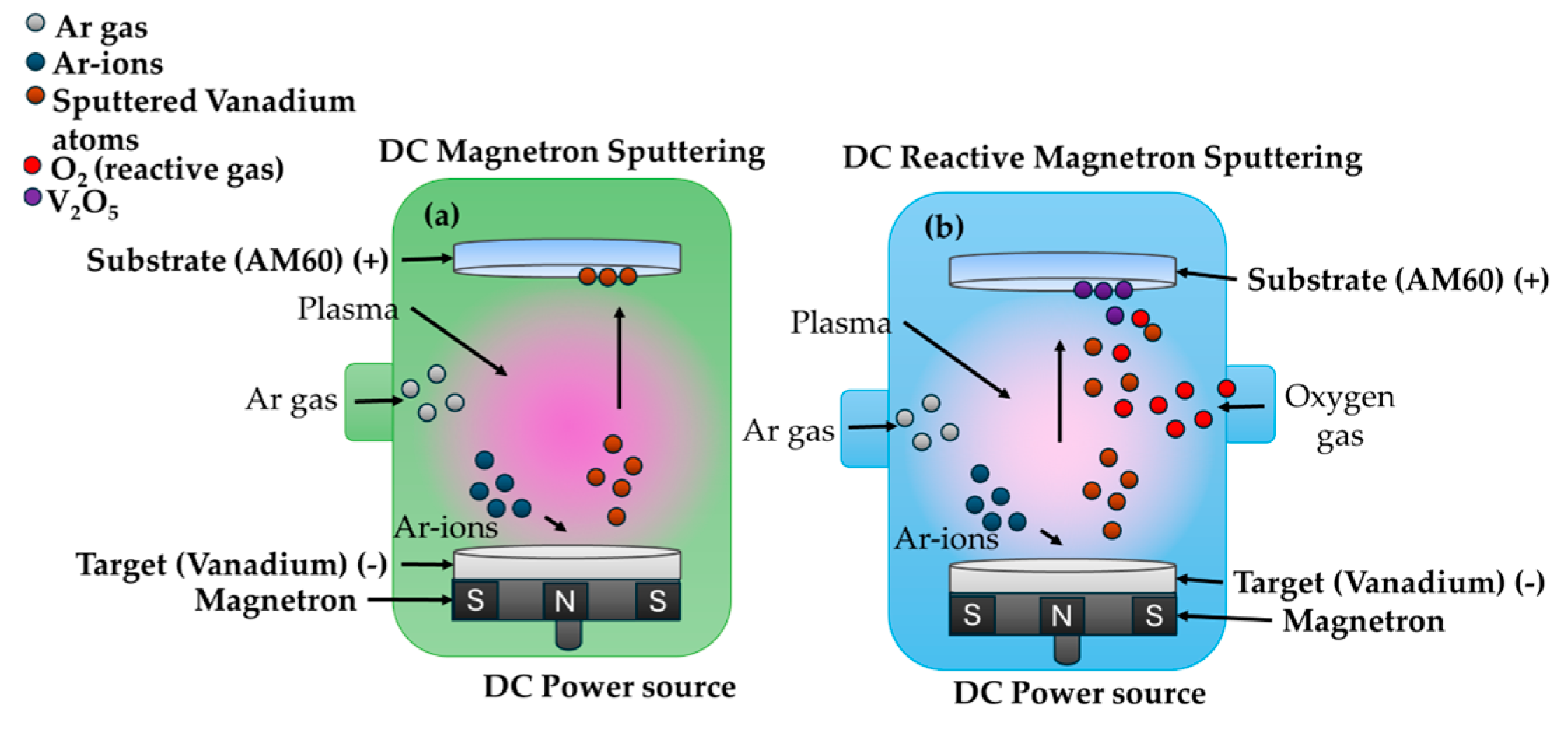
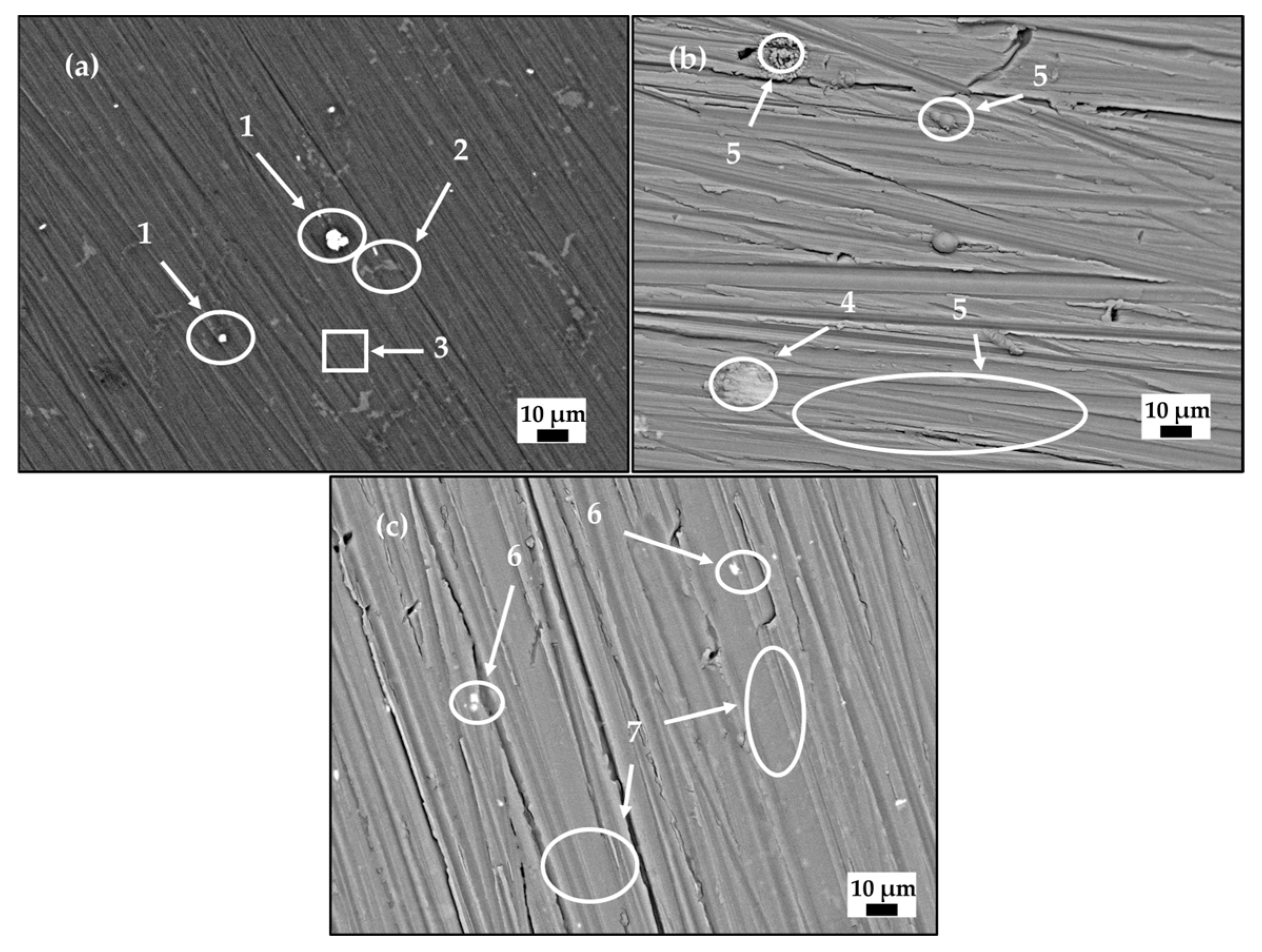



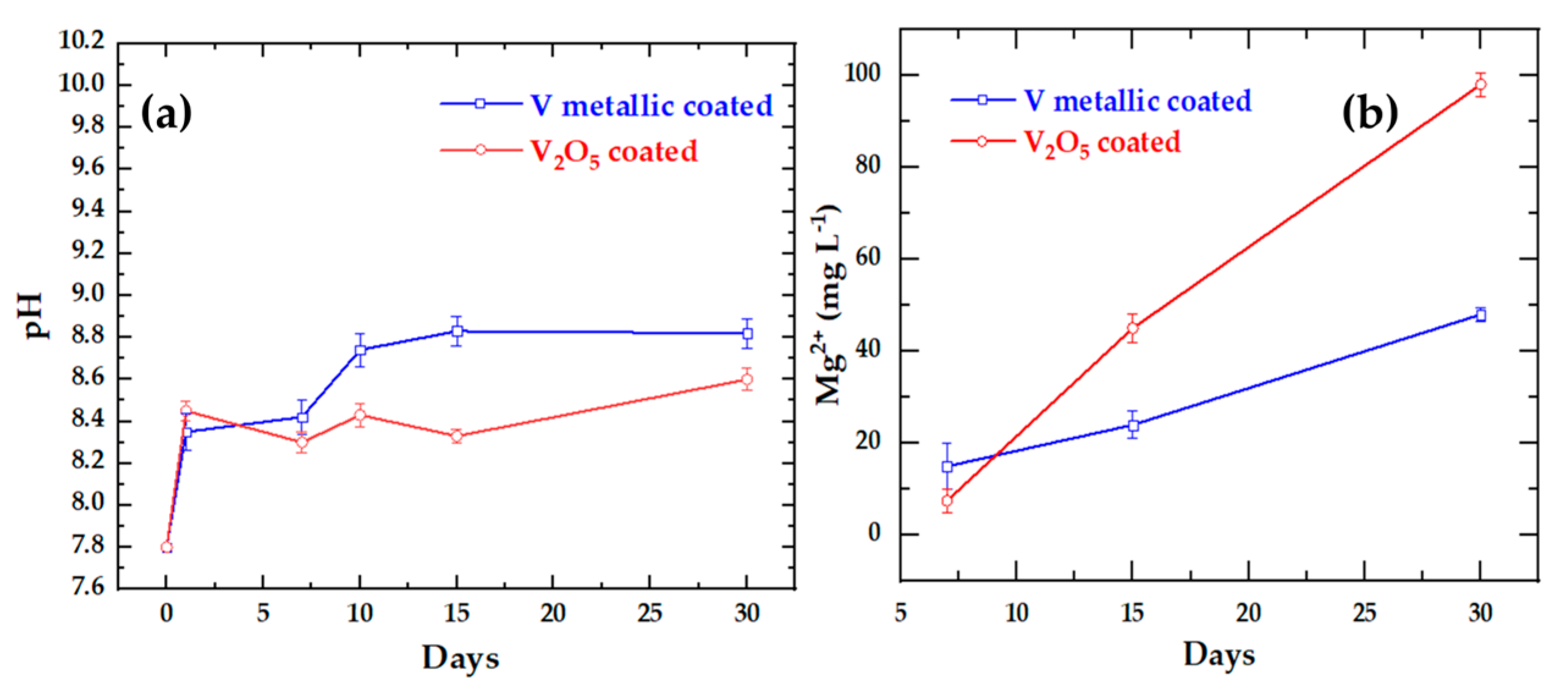
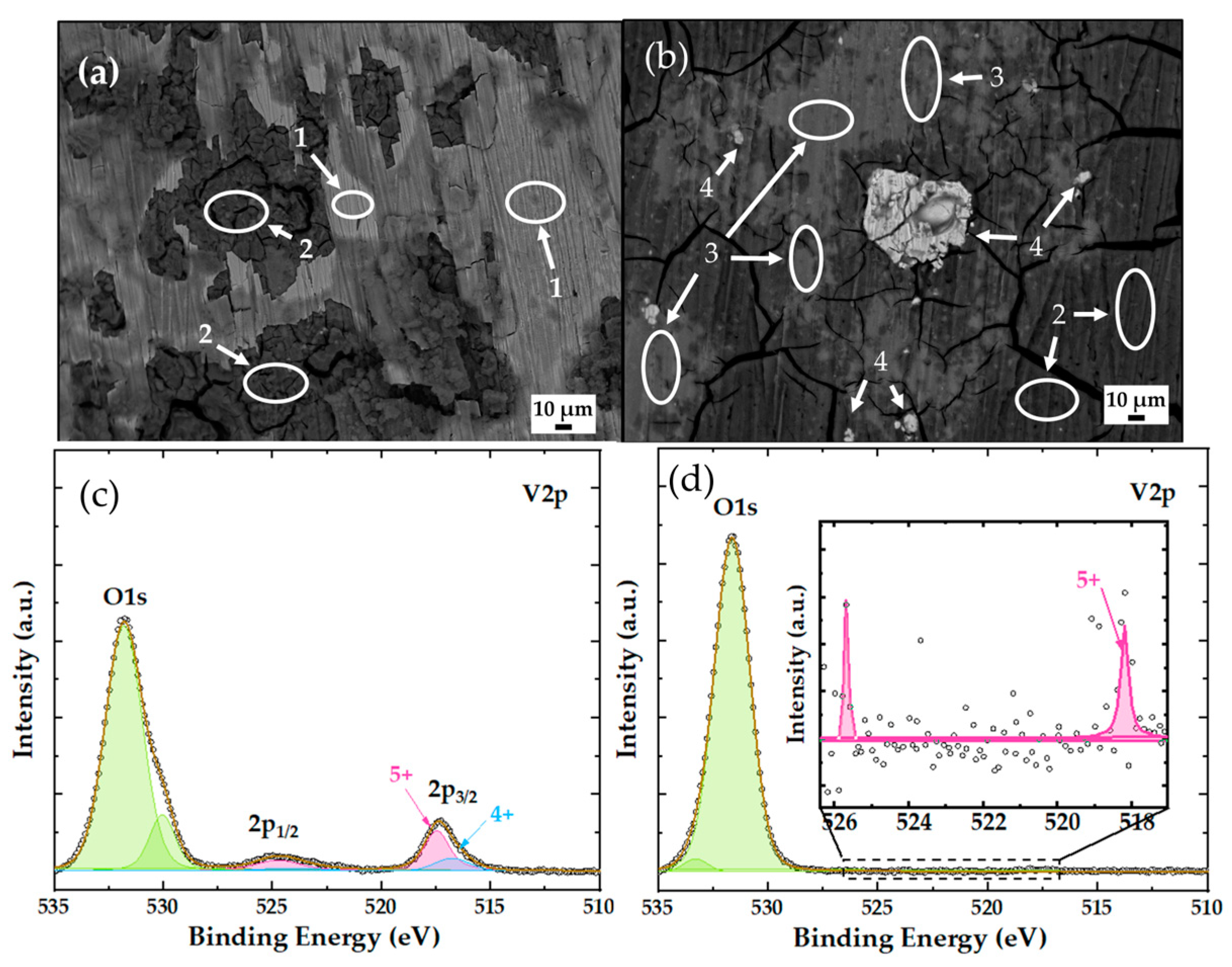
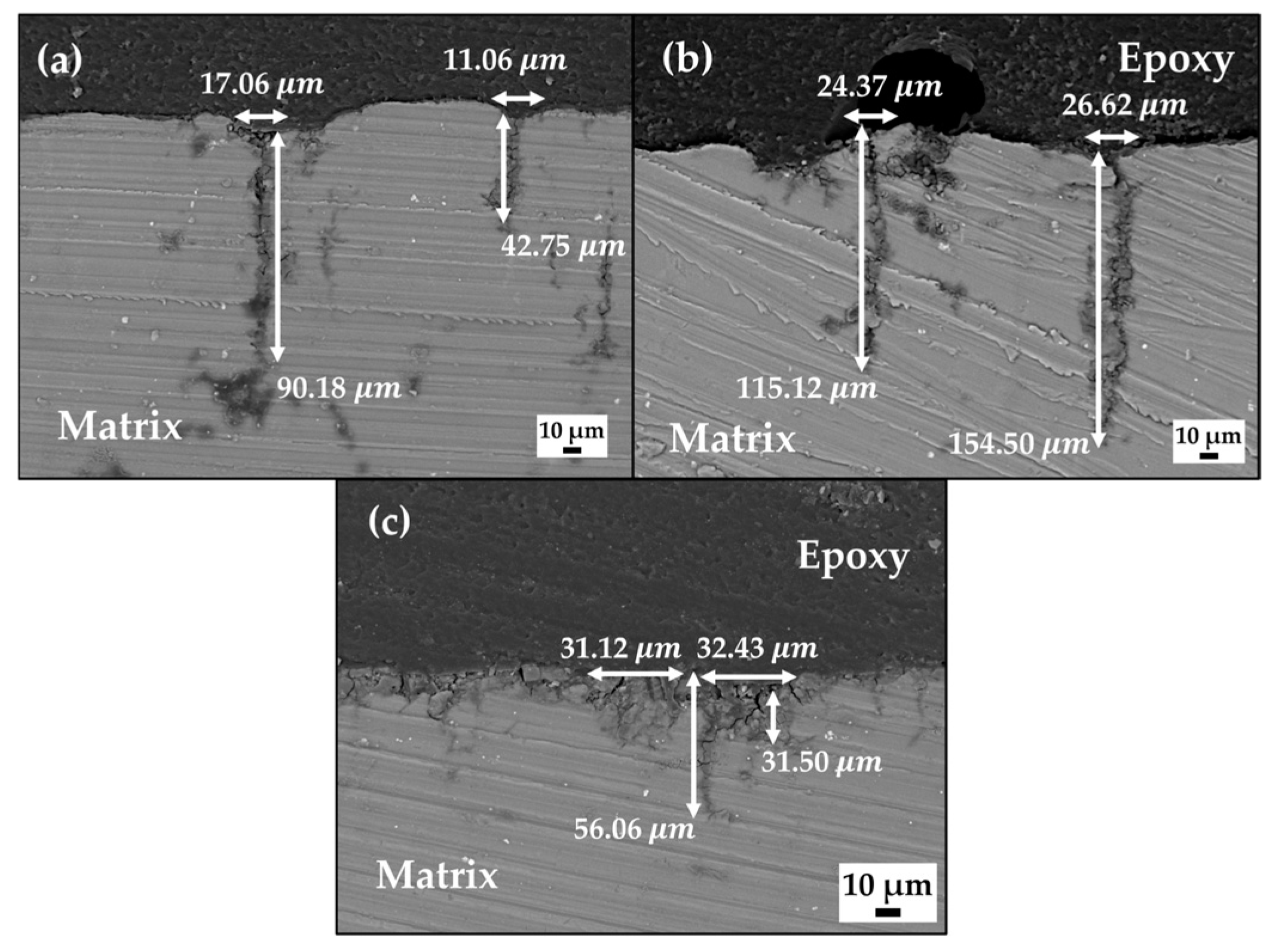
| Element | O | Mg | Al | V | Mn | |
|---|---|---|---|---|---|---|
| AM60 | Zone 1 | 2.93 | 35.07 | 31.47 | - | 30.53 |
| Zone 2 | 1.34 | 76.95 | 21.71 | - | - | |
| Zone 3 | 2.12 | 92.50 | 5.38 | - | - | |
| Vanadium | Zone 4 | 21.84 | 2.50 | 19.24 | 28.59 | 27.83 |
| Zone 5 | 10.58 | 59.81 | 4.20 | 25.40 | - | |
| Zone 6 | 12.99 | 33.14 | 23.27 | 15.32 | 15.28 | |
| Zone 7 | 13.42 | 60.78 | 12.70 | 13.10 | - |
| Element | O | Mg | Al | V | Mn | |
|---|---|---|---|---|---|---|
| Vanadium | Zone 1 | 36.72 | 11.59 | 3.63 | 21.81 | - |
| Zone 2 | 21.72 | 68.53 | 5.67 | - | - | |
| Zone 3 | 11.28 | 66.32 | 14.77 | 6.63 | - | |
| Zone 4 | 31.01 | 14.73 | 17.47 | 0.22 | 35.84 |
Disclaimer/Publisher’s Note: The statements, opinions and data contained in all publications are solely those of the individual author(s) and contributor(s) and not of MDPI and/or the editor(s). MDPI and/or the editor(s) disclaim responsibility for any injury to people or property resulting from any ideas, methods, instructions or products referred to in the content. |
© 2024 by the authors. Licensee MDPI, Basel, Switzerland. This article is an open access article distributed under the terms and conditions of the Creative Commons Attribution (CC BY) license (https://creativecommons.org/licenses/by/4.0/).
Share and Cite
Sánchez, G.; Veleva, L.; Flores, E. Surface Modification of AM60 Mg-Al Alloy with Vanadium and V2O5 Sputtered Deposits: Activity in Marine Ambience. Coatings 2024, 14, 955. https://doi.org/10.3390/coatings14080955
Sánchez G, Veleva L, Flores E. Surface Modification of AM60 Mg-Al Alloy with Vanadium and V2O5 Sputtered Deposits: Activity in Marine Ambience. Coatings. 2024; 14(8):955. https://doi.org/10.3390/coatings14080955
Chicago/Turabian StyleSánchez, Gerardo, Lucien Veleva, and Eduardo Flores. 2024. "Surface Modification of AM60 Mg-Al Alloy with Vanadium and V2O5 Sputtered Deposits: Activity in Marine Ambience" Coatings 14, no. 8: 955. https://doi.org/10.3390/coatings14080955








